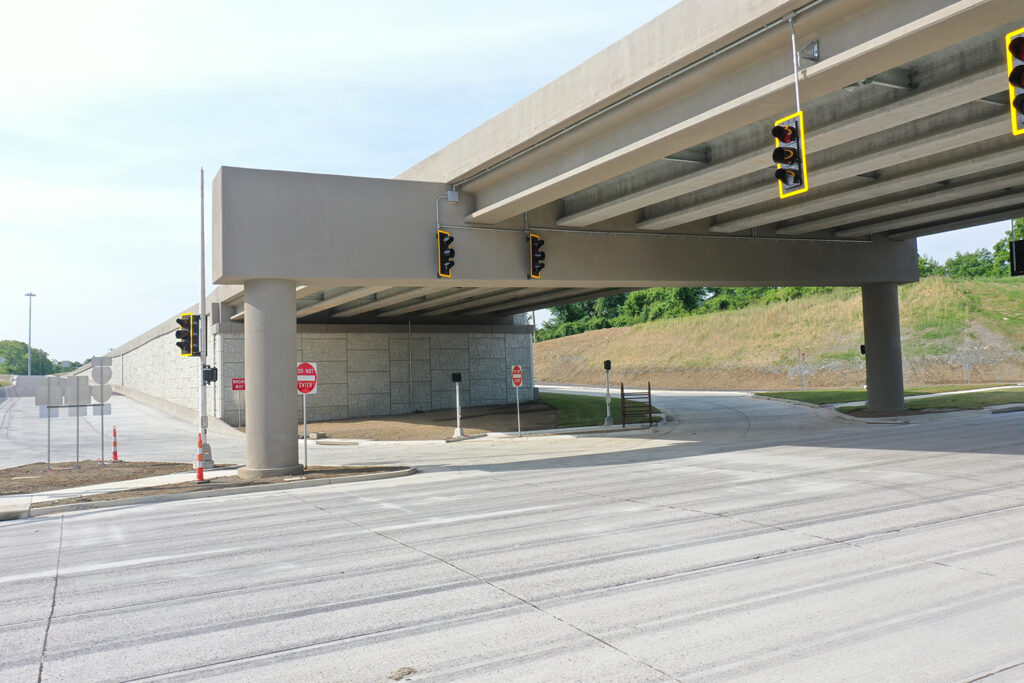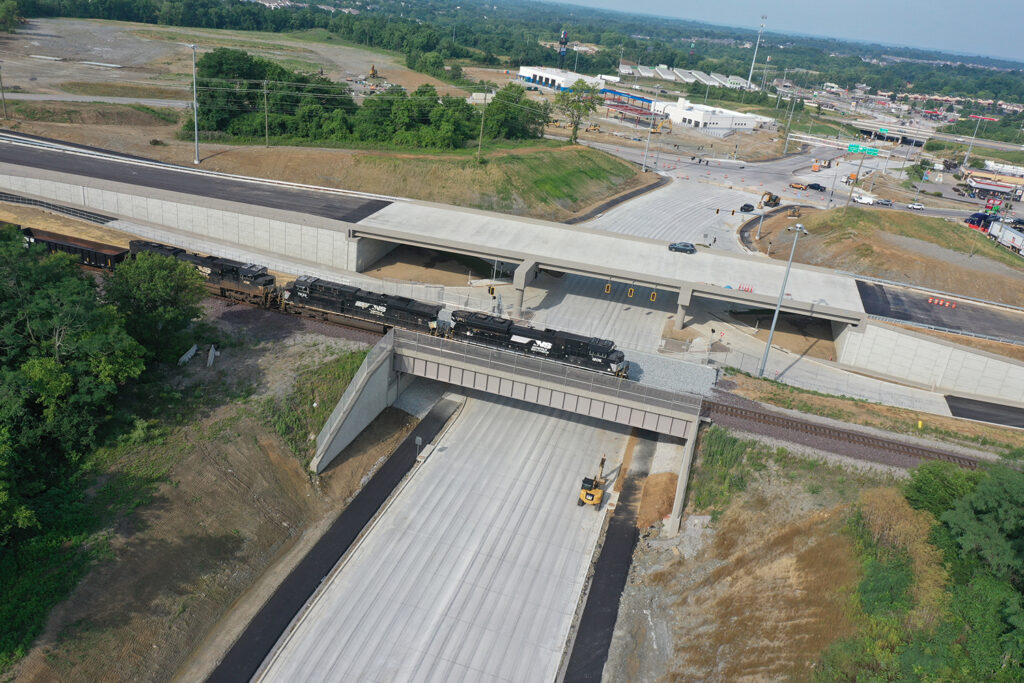What purposes do bridges provide in Kentucky?
With the vast landscapes of Kentucky, bridges provide safe crossing over streams, rivers, lakes, ravines, railways, even over other highways, roads and pathways. Bridges offer safer and more convenient alternative routes, as opposed to ferry crossings or lengthy detours. Thus, bridges reduce travel time, distance, and the risk of accidents, improving overall transportation efficiency and reliability.
Bridges also facilitate transport of goods and commerce, supporting the local economy and providing a safe and more direct route to deliver needed food, resources, and supplies to towns and cities across the Commonwealth and all over the country.
What is the Process for Bridge Construction?
Our procedures for bridge construction are similar to the other services we provide, in that we focus on detailed planning, safety procedures and high quality workmanship at each stage of construction. Every decision we make from with regards to design, safety, materials, budget, process and type is made with the goal to complete each project successfully, safely and with pride over the finished product, rather than making decisions solely based on cost.
Our process of Bridge Construction involves the following phases:
- Phase I: Research and Planning: Before design and site preparation can begin, research on the selected site must be accomplished with engineers evaluating factors such as traffic flow, soil conditions, geological features, hydrology and environmental considerations. Depending on the project feasibility studies and environmental impact assessments may be recommended/required.
- Phase II: Design: With all the above data collected, the engineers will develop detailed designs for the bridge structure, type of bridge, materials needed, dimensions and construction and safety methods. This phase may involve computer-aided design (CAD) software and structural analysis tools to ensure the bridge meets safety and performance requirements.
- Phase III: Site Preparation: Preparing the site before construction can begin may involve excavation, digging, installing cofferdams and other safety structures in order to protect workers and the public, as well as provide erosion control.
- Phase IV: Bridge foundations are erected depending on the bridge plan and design. Determined by the project location variables, specific bridge types provide the greatest stability, load bearing and safety of the bridge. Engineers will determine which of the three foundation types to use after a site inspection depending on the landscape, nearby waterways, slope of the land, ground type, rock depth, and ground resistance. [MORE INFO]
- Phase V: Construction of substructure consists of building the bridge’s support elements, such as piers and abutment.
- Phase VI: Construction of the bridge’s superstructure and bridge deck: The superstructure is the portion that spans the gap and supports the roadway or rail tracks, and may be made of steel, concrete, or a combination of both. The deck is the surface that vehicles, trains or pedestrians traverse. Bridge decks must be durable, skid-resistant, and capable of supporting heavy loads.
- Phase VI: Construction of the bridge deck:
- Phase VII: Finishing touches include installation of installing guardrails, lighting, signage, and drainage systems.
- Phase VIII: Inspections and testing involve structural integrity assessments, load testing, and evaluations of environmental impact mitigation measures.
- Phase IX: Bridge opens to the public.
Throughout the construction process, engineers, project managers, contractors, and our safety manager work together to address challenges, manage risks, and ensure the successful completion of the project within budget and schedule constraints.
What types of Bridges do we Construct and what are the advantages and usages of each?
We have vast knowledge and experience building the following types of bridges:
Precast Concrete Superstructure Bridge:

Location: Mountain Parkway over Johnson Creek in Magoffin County, KY
A precast concrete superstructure bridge is a type of bridge where the main load-bearing elements of the bridge, such as the beams and deck panels, are prefabricated off-site before being transported to the construction site and assembled. The main horizontal load-bearing elements of the bridge, such as beams, are cast in a precast concrete plant and then typically reinforced with steel to provide strength and durability to handle high traffic load.
- Advantages: Precast concrete superstructure bridges offer several advantages, including faster construction times, improved quality control in a factory setting, reduced on-site labor and disruption, and enhanced durability and performance due to the use of high-quality materials and controlled production processes.
- Usage: These advantages make them a popular choice for various bridge projects, ranging from small highway overpasses to large-span river crossings.
Structural Steel Plate Girder Bridge:

Location: I265 over Harrods Creek in Prospect, KY
A Structural Steel Plate Girder Bridge is a type of bridge constructed using steel girders with steel plates welded or bolted together to form the main structural elements. The primary load-bearing members of the bridge are steel plate girders. These girders typically have a box-like or I-beam shape and are fabricated from steel plates welded or bolted together to form the desired cross-sectional shape and size.
- Advantages: Structural Steel Plate Girder Bridges offer several advantages, including high strength-to-weight ratio, durability, versatility in design, and relatively fast construction times compared to other bridge types.
- Usage: These bridges are commonly used for medium to long spans and can be found in various applications, including highway, railway, and pedestrian bridges.
Steel Truss Bridge:

Location: Highway 60 over the Tennessee River in Ledbetter, KY
A steel truss bridge is a type of bridge constructed using a truss framework made primarily of steel components. Truss bridges are known for their characteristic triangular truss structure, which provides strength and stability to span long distances. Trusses are the primary load-bearing elements of the bridge, consisting of interconnected steel members arranged in a triangular pattern.
- Advantages: Steel truss bridges offer several advantages, including high strength-to-weight ratio, durability, versatility in design, and relatively fast construction times compared to other bridge types. The triangular shape of the truss provides strength and stability, allowing the bridge to span long distances without the need for additional support structures.
- Usage: These bridges are commonly used for highway, railway, and pedestrian crossings and can span long distances.
Post Tension Concrete Bridge:

Location: US25 Bridge over Richwood Rd in Richwood, KY
A Post-Tensioned Concrete Bridge is a type of bridge construction method where high-strength steel tendons or cables are placed within concrete elements and tensioned after the concrete has hardened.
- Advantages: Post-tensioning increases the strength and load-carrying capacity of the concrete, allowing for longer spans and reduced material usage. The compression induced by post-tensioning helps control cracking in the concrete, enhancing its durability and resistance to environmental factors such as freeze-thaw cycles and chemical corrosion.
- Usage: Post-tensioned concrete is often preferred for long-span bridges where traditional construction methods may be impractical or uneconomical. With their high traffic load capability, they are suitable for highways, interchanges, and other high-traffic environments where durability and long-term performance are critical.
Railroad Bridges:

Location: Norfolk Southern Railroad over Richwood Rd in Richwood, KY
A railroad bridge, also known simply as a railway bridge or a railroad trestle, is a structure built to carry railway tracks over obstacles such as rivers, valleys, roads, or other railway lines. Railroad bridges are essential components of railway infrastructure, providing safe and efficient passage for trains while overcoming natural or man-made barriers.
A railroad bridge can consist of different types depending on the location and geographical variables of where it’s being placed, so the above four types of bridges can be used to construct a railroad bridge, with similar planning, design and construction procedures. The only difference is the bridge is designed for increased loads for the heavier weights of trains and rail transport.
Why choose Haydon Bridge Company for Bridge Construction?
Experience: We have the most combined experience in bridge construction, a large portfolio of durable bridges throughout the region, our focus on safety is unprecedented, as well as our investment in the best rated and highly innovative equipment – thus making us the premier bridge contractor in Kentucky and the surrounding states. Since 1972, Haydon Bridge Company has offered quality, safe and efficient bridge construction in Kentucky, Ohio, Indiana, West Virginia, Virginia and Tennessee. For over 50 years, Haydon Bridge Company has been family-owned and operated, now spanning three generations, and has built bridges anywhere from 20 feet long to several thousand feet long, with heights of just a few dozen feet from the ground to several hundred feet tall.
*The tallest bridge we have built was over 200’ feet tall and the longest bridge was over 3800 feet long.
Expertise:
Our skilled staff has the knowledge, experience, education and training on how to construct bridges in a variety of situations. Depending on the depth and density of rock, geology of the area, nearby waterways, project budget and costs, and safety of our workers and traveling public, we are well versed in choosing the best materials, bridge type and construction process. And with over 50 years in the industry, we have well established relationships with Civil, Design and Structural Engineers, Specialty Contractors, Surveyors, Geotechnical Engineers, Quality Control Inspectors, etc.
Innovation:
Haydon Bridge’s continual investment in state-of-the-art equipment, software, technical resources, a team of skilled engineers, makes us one of the most competitive Kentucky companies in the bridge construction industry.
Safety:
Our mission statement includes safety as a priority, and it’s the focus of every project we complete and every contract we are awarded. While some may view safety as a requirement, at Haydon Bridge, we view it as a worthy investment in our people that is critical to our continued business success & growth. Our investment into safety includes safety equipment, ongoing safety training, and a full-time safety manager.
“Some companies may view the purchase of safety gear as an expense. At Haydon Bridge, we view it as an investment in our people. The safer our employees are, the more productive our company can be.”
– Bill Pettus, Safety Manager
Successful Execution:
When it comes to bridge construction, we have years of experience on how to efficiently plan out each stage of the work, how to execute the plan, and how to manage the project from start to finish in an organized way with the flexibility to adjust amidst unprecedented obstacles or weather conditions that may arise mid-construction.
“Bridge construction is a very process driven type of work, and we do a really good job of managing the steps in the right order, and accomplishing each in the most efficient, safest and cost-effective way.”
– Kevin Wolfe, President

For nearly 50 years, Haydon Bridge Company has been family-owned and operated, now spanning three generations. Currently co-owned and managed by Kevin Wolfe and Marshall Haydon, their commitment to quality construction and reliable service remains unchanged since the company’s launch in 1972.







